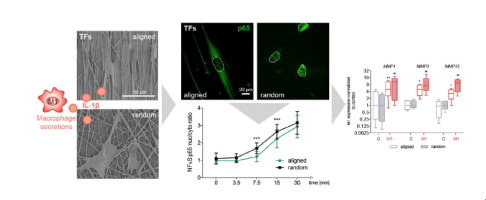Acta Biomaterialia ( IF 9.4 ) Pub Date : 2018-03-10 , DOI: 10.1016/j.actbio.2018.03.004 Angelina D. Schoenenberger , Jasper Foolen , Pascal Moor , Unai Silvan , Jess G. Snedeker

|
Healthy tendon tissue features a highly aligned extracellular matrix that becomes disorganized with disease. Recent evidence suggests that inflammation coexists with early degenerative changes in tendon, and that crosstalk between immune-cells and tendon fibroblasts (TFs) can contribute to poor tissue healing. We hypothesized that a disorganized tissue architecture may predispose tendon cells to degenerative extracellular matrix remodeling pathways, particularly within a pro-inflammatory niche. This hypothesis was tested by analyzing human TFs cultured on electrospun polycaprolactone (PCL) mats with either highly aligned or randomly oriented fiber structures. We confirmed that fibroblast morphology, phenotype, and markers of matrix turnover could be significantly affected by matrix topography. More strikingly, the TF response to paracrine signals from polarized macrophages or by stimulation with pro-inflammatory cytokines featured significant downregulation of signaling related to extracellular synthesis, with significant concomitant upregulation of gene and protein expression of matrix degrading enzymes. Critically, this tendency towards degenerative re-regulation was exacerbated on randomly oriented PCL substrates. These novel findings indicate that highly aligned tendon cell scaffolds not only promote tendon matrix synthesis, but also play a previously unappreciated role in mitigating adverse resident fibroblast response within an inflammatory milieu.
Statement of Significance
Use of biomaterial scaffolds for tendon repair often results in tissue formation characteristic of scar tissue, rather than the highly aligned type-1 collagen matrix of healthy tendons. We hypothesized that non-optimal biomaterial surfaces may play a role in these outcomes, specifically randomly oriented biomaterial surfaces that unintentionally mimic structure of pathological tendon. We observed that disorganized scaffold surfaces do adversely affect early cell attachment and gene expression. We further identified that disorganized fiber surfaces can prime tendon cells to pro-inflammatory signaling. These findings represent provocative evidence unstructured fiber surfaces may underlie inflammatory responses that drive aberrant collagen matrix turnover. This work could be highly relevant for the design of cell instructive biomaterial therapies that yield positive clinical outcomes.
中文翻译:

基质纤维排列介导肌腱细胞对炎症信号的反应
健康的肌腱组织具有高度排列的细胞外基质,该基质变得与疾病无序。最近的证据表明,炎症与肌腱的早期退行性改变并存,并且免疫细胞与肌腱成纤维细胞(TFs)之间的串扰可导致组织愈合不良。我们假设杂乱无章的组织结构可能使肌腱细胞易于发生变性的细胞外基质重塑途径,特别是在促炎性小生境中。通过分析在具有高度对准或随机取向的纤维结构的静电纺丝聚己内酯(PCL)垫上培养的人TF来测试该假设。我们证实,成纤维细胞的形态,表型和基质转换的标记物可能会受到基质形貌的显着影响。更惊人的是 TF对来自极化巨噬细胞或通过促炎性细胞因子刺激的旁分泌信号的反应,其特征是与细胞外合成相关的信号显着下调,同时伴随着基质降解酶的基因和蛋白质表达的显着上调。至关重要的是,在随机定向的PCL基质上,这种退化性重新调节的趋势更加严重。这些新颖的发现表明高度对齐的肌腱细胞支架不仅可以促进肌腱基质的合成,而且在减轻炎症环境中的不利的固有成纤维细胞反应方面也起着以前未曾认识到的作用。伴随着基质降解酶的基因和蛋白质表达的显着上调。至关重要的是,在随机定向的PCL基质上,这种退化性重新调节的趋势更加严重。这些新颖的发现表明高度对齐的肌腱细胞支架不仅可以促进肌腱基质的合成,而且在减轻炎症环境中的不利的固有成纤维细胞反应方面也起着以前未曾认识到的作用。伴随着基质降解酶的基因和蛋白质表达的显着上调。至关重要的是,在随机定向的PCL基质上,这种退化性重新调节的趋势更加严重。这些新颖的发现表明高度对齐的肌腱细胞支架不仅可以促进肌腱基质的合成,而且在减轻炎症环境中的不利的固有成纤维细胞反应方面也起着以前未曾认识到的作用。
重要声明
使用生物材料支架进行肌腱修复通常会导致疤痕组织的组织形成,而不是健康肌腱的高度对齐的1型胶原蛋白基质。我们假设非最佳的生物材料表面可能在这些结果中起作用,特别是随机定向的生物材料表面,其无意中模仿了病理性肌腱的结构。我们观察到混乱的支架表面确实会对早期细胞附着和基因表达产生不利影响。我们进一步确定,混乱的纤维表面可以引发肌腱细胞促炎性信号转导。这些发现表明,非结构化的纤维表面可能是驱动异常胶原基质更新的炎症反应的基础。











































 京公网安备 11010802027423号
京公网安备 11010802027423号